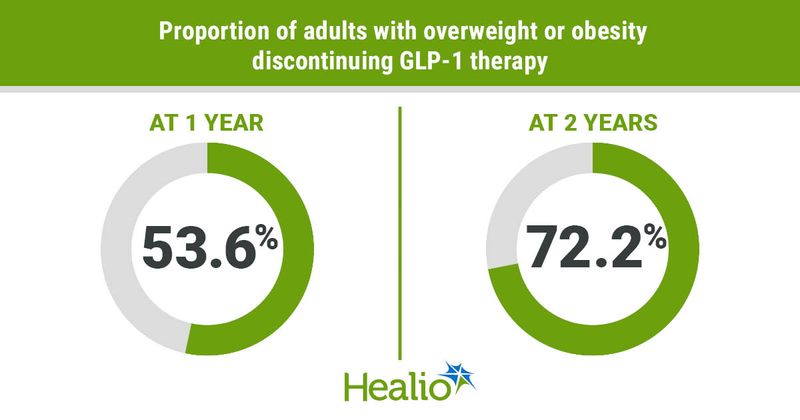Most adults with overweight or obesity discontinue GLP-1 therapy within 2 years
Key takeaways:
- Of adults prescribed a GLP-1 receptor agonist, 53.6% ended therapy at 1 year and 72.2% stopped therapy at 2 years.
- Older adults and those with a lower household income were more likely to stop using a GLP-1.
More than half of adults with overweight or obesity prescribed a GLP-1 discontinue their drug within 1 year, with discontinuation rates higher for those without type 2 diabetes, researchers reported in JAMA Network Open.

“Millions of Americans could benefit from GLP-1s, but clinical trials suggest patients need to stay on these drugs to experience sustained benefits,” Tricia Rodriguez, PhD, MPH, principal applied research scientist at Truveta Research, told Healio. “This study found that the majority of patients stop these drugs within a year, which could be related to how much weight loss they experience, whether they have side effects and how relatively affordable the medications are. This is also the first study to explore how often patients restart these medications. Likely no surprise, we found that when patients regained weight, they were more likely to restart, which is consistent with anecdotal reports.”

Truveta Research conducted the study using data from its collective of health systems across the U.S. Adults with overweight or obesity newly prescribed liraglutide (Victoza/Saxenda, Novo Nordisk), subcutaneous semaglutide (Ozempic/Wegovy, Novo Nordisk) or tirzepatide (Mounjaro/Zepbound, Eli Lilly) from 2018 to 2023 were included. Patients were considered to have discontinued their medication if they went 60 days or more without using a GLP-1, which was calculated based on fill dates and number of days of medication was supplied. Drug reinitiation was considered any fill for a GLP-1 after drug discontinuation.
There were 125,474 adults included in the study (mean age, 54.4 years; 65.4% women; 73.5% white). Of the study population, 61% had type 2 diabetes and the rest did not.
GLP-1 discontinuation
The discontinuation rate of GLP-1 medication was 53.6% at 1 year and 72.2% at 2 years. Adults with type 2 diabetes had lower discontinuation rates at 1 year (46.5% vs. 64.8%) and 2 years (64.1% vs. 84.4%) than those without type 2 diabetes.

Adults aged 65 years and older were more likely to discontinue a GLP-1 than those younger than 65 years regardless of whether they had type 2 diabetes (HR = 1.28; 95% CI, 1.24-1.32) or not (HR = 1.18; 95% CI, 1.13-1.22). The likelihood for discontinuation deceased with higher household income, with the lowest odds for discontinuation among adults with an annual household income of more than $80,000 (HR = 0.72; 95% CI, 0.69-0.75). Each 1 percentage point reduction in body weight from baseline lowered the likelihood for GLP-1 discontinuation by 3%. Adults experiencing moderate or severe gastrointestinal adverse events while on GLP-1 therapy were more likely to stop treatment whether they had type 2 diabetes (HR = 1.38; 95% CI, 1.31-1.45) or not (HR = 1.19; 95% CI, 1.12-1.27).
“These insights emphasize the need for policy changes to improve insurance coverage for individuals without type 2 diabetes, as well as strategies to manage side effects and enhance patient adherence,” Ezekiel Emanuel, MD, PhD, vice provost for Global Initiatives and co-director of the Healthcare Transformation Institute, University of Pennsylvania, told Healio. “Personalized treatment plans that incorporate patient-specific weight loss goals and financial assistance programs may help improve long-term adherence.”
Reinitiation rates
There were 41,792 adults included in the study’s GLP-1 reinitiation analysis. Of the group, 47.3% of those with type 2 diabetes restarted GLP-1 therapy within 1 year and 57.3% restarted medication within 2 years. For those without type 2 diabetes, 36.3% restarted GLP-1 therapy at 1 year and 46.4% reinitiated therapy at 2 years.
Adults aged 65 years and older with type 2 diabetes (HR = 0.88; 95% CI, 0.83-0.94) and without type 2 diabetes (HR = 0.73; 95% CI, 0.66-0.8) were less likely to restart GLP-1 therapy than adults younger than 65 years. Each 1 percentage point weight gain after GLP-1 discontinuation was tied with a 2.3% higher likelihood for therapy reinitiation among adults with type 2 diabetes and 2.8% higher odds for restarting a GLP-1 for those without type 2 diabetes. Adults who experienced moderate or severe gastrointestinal adverse events during initial GLP-1 therapy were less likely to reinitiate treatment, both with type 2 diabetes (HR = 0.86; 95% CI, 0.78-0.95) and without type 2 diabetes (HR = 0.82; 95% CI, 0.72-0.95).
“The high discontinuation rate among patients without type 2 diabetes was striking, reinforcing concerns that insurance barriers limit sustained use for those seeking GLP-1 receptor agonists for weight management,” Emanuel said. “Additionally, the study found that weight gain after stopping was strongly associated with reinitiation, suggesting that many patients may need long-term therapy to maintain weight loss.”
The researchers concluded more studies are needed to explore how long-term health outcomes are tied to GLP-1 discontinuation and to assess how interventions financial barriers to the drugs and mitigate adverse events.
“As the cost, coverage, and supply landscape for GLP-1s evolve, continued research is needed to understand impacts to equitable access and adherence,” Rodriguez said.
For more information:
Ezekiel Emanuel, MD, PhD, and Tricia Rodriguez, PhD, MPH, can be reached at news@truveta.com.

